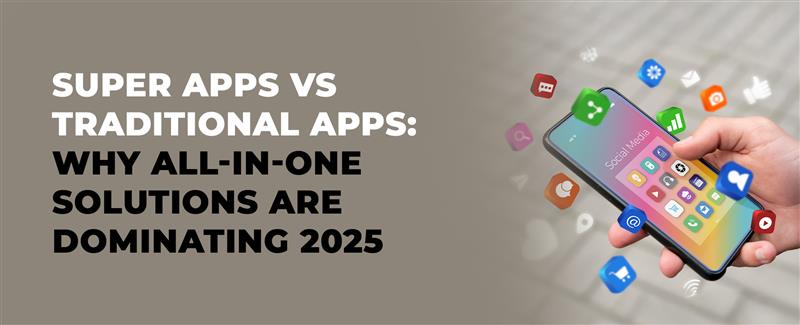Super Apps vs Traditional Apps: Why All-in-One Solutions Are Dominating 2025
26 Sep 25 


The mobile app landscape is undergoing its most significant transformation since the introduction of smartphones.
When was the last time you switched between multiple apps to complete a simple task? Maybe you watched videos on TikTok, then switched to a shopping app to buy something you saw, opened another app to pay your friend back, and finally used a different app to order dinner. This fragmented experience is exactly why super apps are revolutionizing how we interact with mobile technology.
Take TikTok, for example, currently the most trending app of 2025. What started as a short-form video platform is rapidly evolving into a super app ecosystem. Users can now discover and shop products directly within TikTok, watch live streams, and engage with integrated commerce features – all without leaving the app.

This isn’t just another tech trend. With over 4.1 billion consumers already using super apps for daily transactions, and user engagement expected to hit 3.5 billion by the end of 2025, we’re witnessing the biggest shift in mobile app usage since the smartphone was invented.
What is a Super App?
A super app is a comprehensive digital platform that integrates multiple services and functions within a single application. Unlike traditional apps that serve one primary purpose, super apps act as digital ecosystems where users can access various services without switching between different applications.
Think of it as having your entire digital life in one app. Super apps can handle:
- Instant messaging and social networking
- Payment processing and money transfers
- Food delivery and restaurant bookings
- Ride-hailing and transportation
- E-commerce and online shopping
- Banking and financial services
- Entertainment and gaming
- Bill payments and utility management

The Traditional App Challenge: Why Single-Purpose Apps Are Struggling
Traditional apps face increasing pressure in the super app era. Here’s why they’re losing ground:
User Acquisition Costs
App store discovery has become prohibitively expensive. Traditional apps now spend enormous amounts on marketing to attract users who might delete them within days. Super apps, once established, retain users across multiple services, making acquisition costs more sustainable.
Storage Space Limitations
Smartphone storage remains limited, and users are increasingly selective. The average user actively uses only 9-10 apps daily, spending 80% of their time in just 3-4 applications. Super apps position themselves to capture larger portions of this concentrated usage.
Fragmented User Experience
Traditional apps create friction through:
- Multiple Passwords: Users must remember different credentials for each service
- Separate Payment Methods: Different apps require different payment setups
- Inconsistent Interfaces: Each app has unique navigation and design
- Data Silos: Information doesn’t transfer between apps
- Context Switching: Constant app switching disrupts user flow
Market Consolidation
The mobile app market is consolidating around super apps and dominant platforms. Smaller traditional apps find it increasingly difficult to compete with integrated solutions that offer multiple services.
Super Apps vs Traditional Apps: Key Differences
To understand why super apps are revolutionizing the mobile landscape, let’s examine the fundamental differences between super apps and traditional single-purpose applications.

The comparison clearly shows that super apps offer superior integration, efficiency, and user experience compared to managing multiple traditional apps. This fundamental advantage is driving the massive shift toward all-in-one platforms.
Market Data and Growth Projections
The statistics clearly demonstrate that super apps aren’t just growing—they’re fundamentally transforming the mobile economy.
Market Size and Growth

Payment Trends
- Cash transactions: Projected to represent only 12.7% of point-of-sale spending by 2024
- Digital wallet transactions: Forecasted to comprise 33.4% of transactions
- Mobile payment growth: 29.5% growth rate between 2021 and 2026
- Transaction value increase: 60% increase in digital wallet transaction value by 2026
User Behavior

Regional Dominance
- Asia Pacific leads adoption with 60% of global population
- Massive funding: Grab and Gojek combined raised $15 billion
- Market valuations: Grab achieved $14 billion valuation
These numbers represent a fundamental shift in how people interact with mobile technology, providing the foundation for understanding why super apps are becoming the dominant platform choice globally.
Understanding How Super Apps Operate
Super apps customises sophisticated technologies to provide seamless integration across multiple services. Here’s how they work behind the scenes:
Core Operating Principles
Unified User Authentication
Instead of managing separate accounts, super apps use single sign-on systems that work across all integrated services. This eliminates the friction of multiple logins and passwords.
Integrated Payment Systems
Super apps feature built-in payment gateways that handle all financial transactions. Whether you’re paying for food delivery, splitting a bill with friends, or shopping online, the payment process remains consistent.
Data Integration
Super apps collect and analyze user behavior across all services, enabling personalized recommendations and improved user experiences that isolated traditional apps cannot match.
API Integration
These platforms connect with thousands of third-party services through APIs, allowing businesses to plug into the super app ecosystem without developing separate applications.
Cross-Service Features
Super apps enable unique functionalities like ordering food through chat, paying bills while browsing social feeds, or booking rides directly from shopping confirmations.
The technical infrastructure required for super apps is significantly more complex than traditional apps, but this complexity creates the seamless user experience that drives adoption.
The Proven Success Stories
The super app concept isn’t theoretical – it’s already proven successful across Asia, generating billions in revenue and serving millions of users daily.
WeChat: The Original Super App Pioneer
WeChat started as a messaging app but evolved into China’s digital life manager. With over 1.3 billion users, WeChat enables:
- Instant messaging and social networking
- Mobile payments for everything from street vendors to luxury stores
- Mini-programs that function as apps within the app
- Government services and official communications
- E-commerce and online shopping
- Gaming and entertainment
WeChat’s success demonstrated that users prefer integrated platforms over fragmented app experiences.
Grab: Southeast Asia’s Transportation-to-Everything Platform
Grab began as a ride-hailing service but transformed into Southeast Asia’s super app leader:

Gojek: Indonesia’s Digital Ecosystem
Gojek followed a similar trajectory, becoming Indonesia’s go-to platform with approximately $8 billion raised from major technology investors, transforming how millions of Indonesians access digital services.
These platforms didn’t achieve success by accident. They solved real problems by consolidating fragmented digital experiences into unified platforms that users actually want to use.
Why Super Apps Are Winning: The Compelling Advantages
Ultimate User Convenience
Super apps eliminate the frustration of managing multiple applications. Users enjoy:
- Single Login: One account provides access to all services
- Unified Interface: Consistent design language across all functions
- Seamless Transitions: Move between services without switching apps
- Integrated Notifications: All updates and alerts in one place
- Simplified Management: One app to update, one set of preferences to manage
Enhanced Security Through Integration
Super apps provide superior security compared to multiple traditional apps:
- Centralized Security: One platform to secure instead of dozens
- Advanced Authentication: Biometric and multi-factor authentication across all services
- Fraud Prevention: Integrated systems can detect suspicious patterns across services
- Data Protection: Unified privacy controls and data management
- Reduced Attack Surface: Fewer apps mean fewer potential security vulnerabilities
Superior Financial Management
Financial Integration Benefits
- Integrated Wallets: One balance for all transactions
- Spending Tracking: Complete view of expenses across all services
- Instant Transfers: Move money between services without external transfers
- Rewards Integration: Points and benefits across all platform services
- Financial Services: Access to loans, insurance, and investment products
Network Effects and Ecosystem Value
Super apps create powerful network effects that traditional apps cannot match:
- User Growth: More users make the platform more valuable for businesses
- Service Expansion: More services attract more users
- Data Insights: Comprehensive user behavior enables better service recommendations
- Cost Efficiency: Shared infrastructure reduces costs across all services
Key Features That Make Super Apps Successful
Understanding what makes super apps successful reveals why they dominate traditional apps:
Core Features


Advanced Features
Next-Generation Capabilities
Social Integration
- Friend networks across all services
- Social payments and bill splitting
- Group ordering and booking features
- Social commerce capabilities
Business Services
- Merchant payment processing
- Business analytics and insights
- Marketing and promotional tools
- Supply chain management
Financial Services
- Digital banking capabilities
- Loan and credit services
- Insurance products
- Investment and savings options
Security Considerations: Building Trust in Super Apps
Security is paramount for super apps because they handle multiple types of sensitive data across various services.
Essential Security Measures
Multi-Layer Authentication
- Biometric authentication (fingerprint, face ID, voice recognition)
- Two-factor authentication for sensitive transactions
- Device registration and recognition
- Behavioral pattern analysis
Data Protection
- End-to-end encryption for all communications
- Tokenization of payment information
- Secure data storage with regular backups
- Privacy controls for user data management
Transaction Security
- Real-time fraud detection systems
- Transaction limits and controls
- Secure payment processing
- Audit trails for all financial activities
System Security
- Regular security audits and penetration testing
- Compliance with international security standards
- Secure API connections
- Regular security updates and patches
Building User Trust
- Transparent Security Practices: Clearly communicate security measures to users
- Regulatory Compliance: Ensure compliance with local and international regulations
- Incident Response: Develop clear procedures for handling security incidents
Challenges in Super App Development
Developing super apps involves unique challenges that traditional app developers don’t face:
Technical Challenges
Scalability
Super apps must handle massive user bases across multiple services simultaneously. Infrastructure must scale efficiently without compromising performance.
Integration Complexity
Connecting multiple services, payment systems, and third-party providers requires sophisticated technical architecture.
Data Management
Processing and securing vast amounts of user data across different services while maintaining privacy and compliance.
Performance Optimization
Ensuring fast loading times and smooth performance despite the complexity of integrated services.
Business Challenges
- Regulatory Compliance: Complex regulations across multiple industries
- Partnership Management: Coordinating with numerous service providers
- Market Entry: Competing with established players
- Monetization Balance: Finding the right balance between growth and revenue
User Experience Challenges
- Complexity Management: Making sophisticated functionality feel simple
- Service Discovery: Helping users discover new services without overwhelming them
- Consistency: Maintaining consistent user experience across diverse services
The Future of Super Apps: What’s Coming Next
Super apps are evolving rapidly, with several trends shaping their future development:

How Mindster Can Help You Build Your Super App
At Mindster, we understand that developing a successful super app requires more than just technical expertise—it demands strategic vision, comprehensive planning, and execution excellence.
Our Super App Development Expertise
Comprehensive Solution Architecture
We design scalable, modular architectures that can seamlessly integrate multiple services while maintaining optimal performance. Our technical team has extensive experience building complex platforms that handle millions of users and transactions.
End-to-End Development Services
- Strategic consultation and market analysis
- UI/UX design optimized for multi-service platforms
- Backend infrastructure development and cloud deployment
- Payment gateway integration and financial services
- Third-party API integrations and service partnerships
- Security implementation and compliance management
- Quality assurance and performance testing
- Launch support and post-deployment maintenance
Six Essential Steps to Build a Super App
Creating a successful super app requires strategic planning and execution. Here’s the proven development process:
1. Market Research and Strategy Development
Duration: 4-6 weeks
- Identify target market and user needs
- Competitive analysis of existing solutions
- Service selection based on market demand
- Regulatory compliance roadmap
2.Technology Infrastructure Planning
Duration: 3-4 weeks
- Scalable architecture design
- Security framework implementation
- API and integration planning
- Database and cloud infrastructure
3. User Experience and Interface Design
Duration: 6-8 weeks
- Unified design system creation
- Navigation architecture design
- Interactive prototype development
- Accessibility and usability testing
4. MVP Development and Testing
Duration: 16-24 weeks
- Core service development
- Payment system integration
- Security implementation
- Comprehensive user testing
5. Service Integration and Expansion
Duration: 8-12 weeks
- Third-party service connections
- Additional service implementation
- Cross-service feature development
- Performance optimization
6. Launch and Continuous Improvement
Duration: Ongoing
- Soft launch and user feedback
- Marketing and user acquisition
- Performance monitoring
- Feature expansion and updates
Final Thoughts
At Mindster, we’re ready to help you capitalize on this massive market opportunity. Our proven expertise in fintech solutions, multi-platform development, and scalable architecture makes us the ideal partner for your super app journey.
Ready to build the next generation super app? Contact Mindster today for a free consultation and discover how we can transform your vision into a market-leading platform that defines the future of digital experiences.
Frequently Asked Questions (FAQs)
1. How do super apps differ from traditional apps?
Super apps integrate multiple services within a single platform, while traditional apps focus on one primary function. Super apps offer messaging, payments, food delivery, ride-hailing, and more in one app, whereas traditional apps require users to download separate applications for each service.
2. Are super apps secure for financial transactions?
Yes, super apps implement multiple layers of security including biometric authentication, end-to-end encryption, tokenization, and real-time fraud detection. Many super apps actually provide better security than using multiple traditional apps because they centralize and strengthen security measures.
3. What services can I access through super apps?
Super apps typically offer instant messaging, digital payments, food delivery, ride-hailing, e-commerce shopping, bill payments, financial services, entertainment, and various other services depending on the platform and region.
4. Which super app should I choose?
The best super app depends on your location and needs. WeChat dominates in China, Grab leads in Southeast Asia, and various regional super apps serve different markets. Consider factors like available services, security features, user interface, and local merchant acceptance.
5. How much does it cost to develop a super app?
Super app development typically costs between $1-5 million for basic functionality and $10-50 million for comprehensive platforms. The exact cost depends on features, geographic scope, regulatory requirements, and integration complexity.
6. Can traditional apps compete with super apps?
Traditional apps can compete by focusing on specialized niches, superior user experiences, or by partnering with super app platforms. However, many traditional apps are finding it increasingly difficult to compete with the convenience and integration that super apps provide.
- Agentic AI1
- Android Development3
- Artificial Intelligence31
- Classified App3
- Custom App Development5
- Digital Transformation12
- Doctor Appointment Booking App14
- Dropshipping1
- Ecommerce Apps40
- Education Apps2
- Fintech-Apps37
- Fitness App4
- Flutter4
- Flutter Apps20
- Food Delivery App5
- Grocery App Development1
- Grocery Apps3
- Health Care10
- IoT2
- Loyalty Programs9
- Matrimony Apps1
- Microsoft1
- Mobile App Maintenance2
- Mobile Apps126
- Product Engineering6
- Progressive Web Apps1
- React Native Apps2
- Saas Application2
- Shopify9
- Software Development3
- Taxi Booking Apps7
- Truck Booking App5
- UI UX Design8
- Uncategorized6
- Web App Development1

















Comments